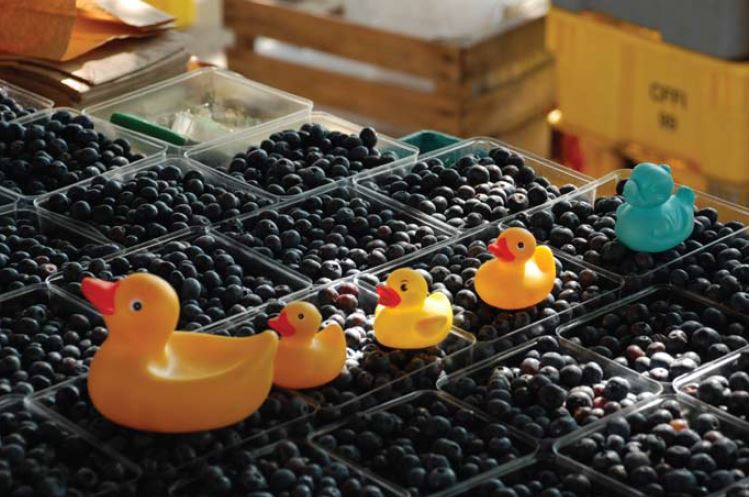Variety is Key to Ann Arbor Farmers Market's Success
Access to great food at local farmers’ markets is becoming commonplace to the point that we hardly bat an eye at the sight of an heirloom tomato or a slender Ichiban eggplant. But fava beans, emu eggs and huitlacoche (Mexican truffles)? The seasonal, often specialized selections at the Ann Arbor Farmers’ Market are enough to turn any foodie’s head. And on any given market day, the perfume of freshly cut basil, locally roasted coffee and steaming hot Salvadorian tamales all but guarantees shoppers will return home with more than just the staple salad vegetables.
The Ann Arbor Farmers Market is open year-round on Saturdays and on Wednesdays from April through December. During the highest points of the growing season, vendors work tirelessly the night before loading trucks with their wares and preparing their vegetables for sale. Some leave in the wee hours of the morning to drive in from the western side of the state, though most of the vendors are from a smaller radius surrounding the Ann Arbor area.
Vendors know to set up their stands early, because a loyal contingent of early birds is bound to show up ready to have the first pick of the small harvest items like red currants or pristine squash blossoms. By late morning, the buzz of excited shoppers often reaches fever pitch as they fill bags with local meat, freshly milled flour, eggs, artisanal breads, cheeses, chocolates and pastries. There is an even mix of farmers selling conventionally raised, “no spray” and organic produce. The market also serves as a hub for several local CSAs.
Variety at this market is exceptional—with as many as four types of broad-leafed chard to choose from, all the way down to flats and bins of tender microgreens, it is no surprise that the market attracts area chefs who have a proclivity for working culinary magic with local bounty. While the sheer volume and selection could be daunting, the vendors are eager to help, offering cooking tips and sure-fire recipes. Do not despair—your neighborly farmer has plenty of suggestions for turning that absurd looking kohlrabi into a great side dish. Following your grocery shopping, there are plenty of opportunities for snacking, both at the market and in the nearby restaurants, cafes and specialty shops of Kerrytown.
The historic market has had plenty of time to grow into its present incarnation—a diverse mix of producers of locally grown, raised and prepared foods and plants along with a small handful of handicrafts. The market was originally established in 1919 and in 1931 moved a few blocks down to its current location between Fourth Avenue and Detroit Street. Since that time the market has seen its share of change, including the close of the adjacent lumber yard, grain mill and feed store, the expansion of the city of Ann Arbor, which included renovation of those buildings and the establishment of the Kerrytown District.
For a time, it looked as though the explosion of giant agribusiness might render the farmers’ market obsolete. But in the last ten years the Ann Arbor market, like many others across the country, has experienced a renaissance, which has translated into packed stalls and vendors spilling out from the covered walkways. While the market adds vendors every year, there are many famers that have been coming for a very long time. On this year’s application, according to market manager Molly Notarianni, one farmer stated that this would be his 75th season at the market. Clearly, there is dedication to bring quality food to the people of Ann Arbor that can stand the test of time.
The market has a clear mission to increase its contribution to the community beyond the provision of fresh food. “We want to continue to expand the market as a community resource, whether that means getting school groups to come and tour the market on Wednesdays or having cooking demonstrations and live music on Saturdays,” says Notarianni. “We want it to be a festive, welcoming environment.”
In order to serve a more diverse group of customers and promote healthy food for all, the market has many vendors who accept Project Fresh coupons, a food assistance program sponsored by the Michigan Department of Community Health and Michigan State Extension. By the end of this season, says Notarianni, the market will be equipped to start accepting EBT cards (food stamps) as well.
“We also have several market renovations planned for the next year or so,” says Notarianni. The city of Ann Arbor plans to use the market’s high visibility within the community as way to draw attention to sustainability projects. Solar panels were installed this year, and there are plans for a pavilion, underground water catchment systems and even potential for a green roof.
As the weather turns colder and the first frost claims the last of the summertime fruits and vegetables, the Ann Arbor Farmers’ Market perseveres through even the coldest Saturdays. Now is the time to stock up on root vegetables and winter squashes. Through the winter months the market still offers enough to put together a respectable meal: hoop-house grown baby greens, apples, cider, eggs, maple syrup, honey, breads and local meats.
Learn more at Ann Arbor Farmers Market







